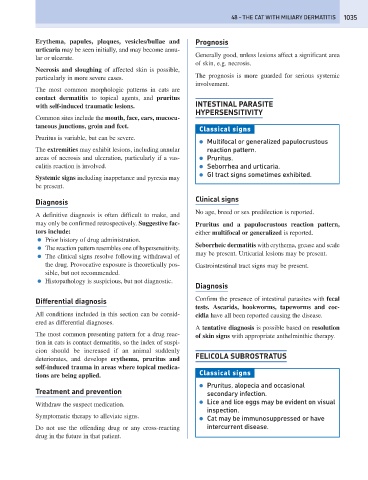Page 1043 - Problem-Based Feline Medicine
P. 1043
48 – THE CAT WITH MILIARY DERMATITIS 1035
Erythema, papules, plaques, vesicles/bullae and Prognosis
urticaria may be seen initially, and may become annu-
Generally good, unless lesions affect a significant area
lar or ulcerate.
of skin, e.g. necrosis.
Necrosis and sloughing of affected skin is possible,
The prognosis is more guarded for serious systemic
particularly in more severe cases.
involvement.
The most common morphologic patterns in cats are
contact dermatitis to topical agents, and pruritus
with self-induced traumatic lesions. INTESTINAL PARASITE
HYPERSENSITIVITY
Common sites include the mouth, face, ears, mucocu-
taneous junctions, groin and feet.
Classical signs
Pruritus is variable, but can be severe.
● Multifocal or generalized papulocrustous
The extremities may exhibit lesions, including annular reaction pattern.
areas of necrosis and ulceration, particularly if a vas- ● Pruritus.
culitis reaction is involved. ● Seborrhea and urticaria.
● GI tract signs sometimes exhibited.
Systemic signs including inappetance and pyrexia may
be present.
Diagnosis Clinical signs
No age, breed or sex predilection is reported.
A definitive diagnosis is often difficult to make, and
may only be confirmed retrospectively. Suggestive fac- Pruritus and a papulocrustous reaction pattern,
tors include: either multifocal or generalized is reported.
● Prior history of drug administration.
Seborrheic dermatitis with erythema, grease and scale
● The reaction pattern resembles one of hypersensitivity.
may be present. Urticarial lesions may be present.
● The clinical signs resolve following withdrawal of
the drug. Provocative exposure is theoretically pos- Gastrointestinal tract signs may be present.
sible, but not recommended.
● Histopathology is suspicious, but not diagnostic.
Diagnosis
Differential diagnosis Confirm the presence of intestinal parasites with fecal
tests. Ascarids, hookworms, tapeworms and coc-
All conditions included in this section can be consid- cidia have all been reported causing the disease.
ered as differential diagnoses.
A tentative diagnosis is possible based on resolution
The most common presenting pattern for a drug reac- of skin signs with appropriate anthelminthic therapy.
tion in cats is contact dermatitis, so the index of suspi-
cion should be increased if an animal suddenly
FELICOLA SUBROSTRATUS
deteriorates, and develops erythema, pruritus and
self-induced trauma in areas where topical medica-
Classical signs
tions are being applied.
● Pruritus, alopecia and occasional
Treatment and prevention secondary infection.
● Lice and lice eggs may be evident on visual
Withdraw the suspect medication.
inspection.
Symptomatic therapy to alleviate signs. ● Cat may be immunosuppressed or have
Do not use the offending drug or any cross-reacting intercurrent disease.
drug in the future in that patient.

